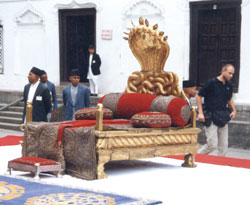 Five years after the royal massacre, it took a people's uprising to finally force the monarchy to lose its power, position and privileges. Even if this historic institution survives the constituent assembly, the king will no longer reign or rule. To remain is the only option he is likely to be left with. Uneasy lies the head that wears the bird of paradise crown.
Five years after the royal massacre, it took a people's uprising to finally force the monarchy to lose its power, position and privileges. Even if this historic institution survives the constituent assembly, the king will no longer reign or rule. To remain is the only option he is likely to be left with. Uneasy lies the head that wears the bird of paradise crown. The concept of republican monarchy seems to be taking shape in what was once the world's only Hindu kingdom. All it took was five years for King Gyanendra to discredit and dismantle this hallowed institution. His brother had carefully crafted the throne to keep his line intact but his murder most foul transformed a large section of Nepali population overnight into republicans.
In one of those twists of destiny, the perception about Narayanhiti Massacre became an accepted reality when a desolate population rejected the report of the royal investigation committee. As the direct beneficiary of the 1 June, 2001 Friday evening slaughter of royals in the palace King Gyanendra could never explain convincingly the escape of his immediate family from a massacre that claimed the life of at least nine of his relatives. From then on, it was a losing battle for the king. It didn't do his image a whole lot of good when he went on an autocratic spree.
Within a month of King Gyanendra's ascension, prime minister Girija Prasad Koirala had to resign under duress: the army had refused to obey his order to deploy in Holeri. Five years later, the generals are now taking orders from parliament and the army has been stripped of its 'royal' prefix.
But Koirala's successor in Singh Darbar began to act as if the wishes of the king were his sole command. The term of the local government units was allowed to lapse, defence expenditure was unlimited, a state of emergency was declared and then extended.
Sher Bahadur Deuba's ambitions led to the vertical division of the NC, the only party in the country that had stood by the idea of constitutional monarchy throughout its history. And to cap it all, King Gyanendra dissolved parliament in the dead of the night on 22 May 2002 upon the recommendation of a prime minister who had lost the confidence of his own party.
If a date were to be put upon the demise of the 1990 constitution that enshrined the king as a part of the legislative as well as the executive, it has to be the day when the lower house of the parliament was dissolved in full knowledge that it could never be reconstituted through elections within the stipulated six months.
The king ruled as an absolute monarch until the day his authority was was brought downlast month.
Five years after 4 June, 2001, the day comatose King Dipendra was declared dead and the Shah crown shifted from the head of a crown prince to that of a royal regent, it's tempting to envision whether the king could have acted differently and saved the monarchy and from the tremendous personal humiliation to himself. In hindsight, it can be argued that had he stuck strictly to the law perhaps the public resentment would have cooled off. But he never gave himself that chance.
The king continued to act as if time had stood still. His 4 October, 2002 takeover and 1 February, 2005 royal-military coup will go down in Nepali history as the twin blows that undermined the pedestals of the monarchy. The socio-cultural roots of kingship were cut in Narayanhiti Massacre. February First completed the process of its political isolation.
Since the myth of Nepali nationalism centred around the 'one language, one people, and one nation under one king' is still quite strong, a symbolic monarchy may yet survive the forces of democratisation unleashed by the April Uprising. But in spirit and substance, Nepal is already a republic.



